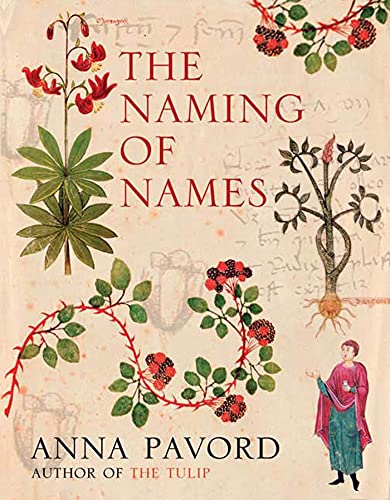
Synopsis
An exhilarating new book from the author of the worldwide bestseller The Tulip.
The Naming of Names traces the search for order in the natural world, a search that for hundreds of years occupied some of the most brilliant minds in Europe.
Redefining man's relationship with nature was a major pursuit during the Renaissance. But in a world full of poisons, there was also an urgent practical need to name and recognize different plants, because most medicines were made from plant extracts.
Anna Pavord takes us on a thrilling adventure into botanical history, traveling from Athens in the third century BC, through Constantinople, Venice, the medical school at Salerno to the universities of Pisa and Padua. The journey, traced here for the first time, involves the culture of Islam, the first expeditions to the Indies and the first settlers in the New World.
In Athens, Aristotle's pupil Theophrastus was the first man ever to write a book about plants. How can we name, sort, and order them? He asked. The debate continues still, two thousand years later. Sumptuously illustrated in full colour, The Naming of Names gives a compelling insight into a world full of intrigue and intensely competitive egos.
"synopsis" may belong to another edition of this title.
About the Author
Anna Pavord is the author of the best-selling title The Tulip.
Reviews
Pavord, author of the The Tulip and an expert gardener, traces the history of plant taxonomy from the ancient Greeks to 17th-century British botanist John Ray in this hefty tome, and though her passion for plants is apparent on every page, readers who don't share the same level of enthusiasm will be frustrated by Pavord's encyclopedic approach. Pavord, in prose as rich and colorful as the too-infrequent illustrations, contextualizes plant classification within larger intellectual, political and cultural spheres, but she verges dangerously close to writing a textbook; the vast amount of information she packs into brief, rapid-fire sections can overwhelm. In the best sections, she slows down to draw detailed portraits of researchers and describe how each contributed to the slowly evolving (and, until the late 1600's, unnamed) science of botany. Ray, for instance, marked "a quiet, lonely, dogged consummation" with "no fireworks, no claps of thunder, no swelling symphonic themes" when, shortly before his death and suffering from gangrene, he penned the six fundamental rules of botany. Pavord's prose dazzles, but it's not enough to carry readers with a casual interest in plants or gardening through an otherwise dense history.
Copyright © Reed Business Information, a division of Reed Elsevier Inc. All rights reserved.
"About this title" may belong to another edition of this title.
Search results for The Naming of Names: The Search for Order in the World...
The Naming of Names: The Search for Order in the World of Plants
Seller: World of Books (was SecondSale), Montgomery, IL, U.S.A.
Condition: Very Good. Item in very good condition! Textbooks may not include supplemental items i.e. CDs, access codes etc. Seller Inventory # 00090920982
The Naming of Names: The Search for Order in the World of Plants
Seller: World of Books (was SecondSale), Montgomery, IL, U.S.A.
Condition: Good. Item in good condition. Textbooks may not include supplemental items i.e. CDs, access codes etc. Seller Inventory # 00089524937
The Naming of Names: The Search for Order in the World of Plants
Seller: Your Online Bookstore, Houston, TX, U.S.A.
hardcover. Condition: Good. Seller Inventory # 1596910712-3-34731392
The Naming of Names: The Search for Order in the World of Plants
Seller: HPB-Diamond, Dallas, TX, U.S.A.
Hardcover. Condition: Very Good. Connecting readers with great books since 1972! Used books may not include companion materials, and may have some shelf wear or limited writing. We ship orders daily and Customer Service is our top priority! Seller Inventory # S_445424547
The Naming of Names: The Search for Order in the World of Plants
Seller: ThriftBooks-Dallas, Dallas, TX, U.S.A.
Hardcover. Condition: As New. No Jacket. Pages are clean and are not marred by notes or folds of any kind. ~ ThriftBooks: Read More, Spend Less. Seller Inventory # G1596910712I2N00
The Naming of Names: The Search for Order in the World of Plants
Seller: ThriftBooks-Reno, Reno, NV, U.S.A.
Hardcover. Condition: Very Good. No Jacket. May have limited writing in cover pages. Pages are unmarked. ~ ThriftBooks: Read More, Spend Less. Seller Inventory # G1596910712I4N00
The Naming of Names: The Search for Order in the World of Plants
Seller: ThriftBooks-Atlanta, AUSTELL, GA, U.S.A.
Hardcover. Condition: Very Good. No Jacket. May have limited writing in cover pages. Pages are unmarked. ~ ThriftBooks: Read More, Spend Less. Seller Inventory # G1596910712I4N00
The Naming of Names: The Search for Order in the World of Plants
Seller: ThriftBooks-Dallas, Dallas, TX, U.S.A.
Hardcover. Condition: Very Good. No Jacket. May have limited writing in cover pages. Pages are unmarked. ~ ThriftBooks: Read More, Spend Less. Seller Inventory # G1596910712I4N00
The Naming of Names: The Search for Order in the World of Plants
Seller: ThriftBooks-Phoenix, Phoenix, AZ, U.S.A.
Hardcover. Condition: Very Good. No Jacket. May have limited writing in cover pages. Pages are unmarked. ~ ThriftBooks: Read More, Spend Less. Seller Inventory # G1596910712I4N00
The Naming of Names: The Search for Order in the World of Plants
Seller: ThriftBooks-Dallas, Dallas, TX, U.S.A.
Hardcover. Condition: Very Good. No Jacket. Missing dust jacket; May have limited writing in cover pages. Pages are unmarked. ~ ThriftBooks: Read More, Spend Less 3.04. Seller Inventory # G1596910712I4N01
